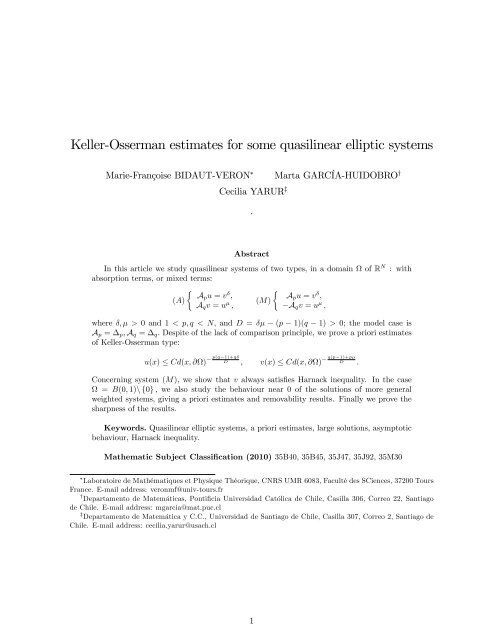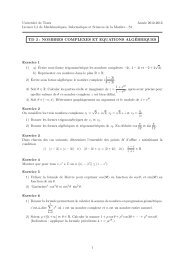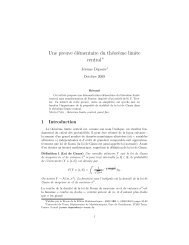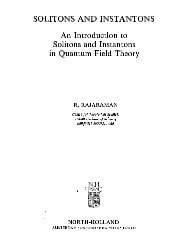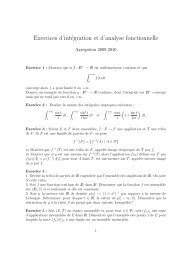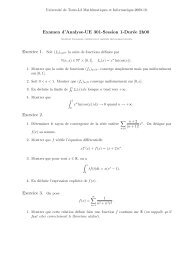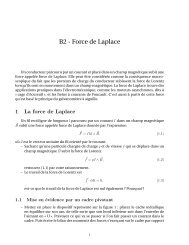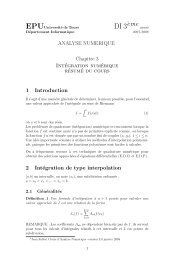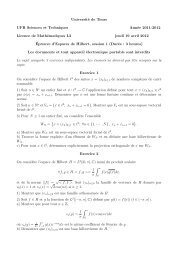Keller-Osserman estimates for some quasilinear elliptic ... - LMPT
Keller-Osserman estimates for some quasilinear elliptic ... - LMPT
Keller-Osserman estimates for some quasilinear elliptic ... - LMPT
You also want an ePaper? Increase the reach of your titles
YUMPU automatically turns print PDFs into web optimized ePapers that Google loves.
<strong>Keller</strong>-<strong>Osserman</strong> <strong>estimates</strong> <strong>for</strong> <strong>some</strong> <strong>quasilinear</strong> <strong>elliptic</strong> systemsMarie-Françoise BIDAUT-VERON ∗ Marta GARCÍA-HUIDOBRO †Cecilia YARUR ‡.AbstractIn this article we study <strong>quasilinear</strong> systems of two types, in a domain Ω of R N : withabsorption terms, or mixed terms:(A)Ap u = v δ ,A q v = u µ ,Ap u = v(M)δ ,−A q v = u µ ,where δ, µ > 0 and 1 < p, q < N, and D = δµ − (p − 1)(q − 1) > 0; the model case isA p = ∆ p , A q = ∆ q . Despite of the lack of comparison principle, we prove a priori <strong>estimates</strong>of <strong>Keller</strong>-<strong>Osserman</strong> type:u(x) ≤ Cd(x, ∂Ω) − p(q−1)+qδD , v(x) ≤ Cd(x, ∂Ω) − q(p−1)+pµD .Concerning system (M), we show that v always satisfies Harnack inequality. In the caseΩ = B(0, 1)\ {0} , we also study the behaviour near 0 of the solutions of more generalweighted systems, giving a priori <strong>estimates</strong> and removability results. Finally we prove thesharpness of the results.Keywords. Quasilinear <strong>elliptic</strong> systems, a priori <strong>estimates</strong>, large solutions, asymptoticbehaviour, Harnack inequality.Mathematic Subject Classification (2010) 35B40, 35B45, 35J47, 35J92, 35M30∗ Laboratoire de Mathématiques et Physique Théorique, CNRS UMR 6083, Faculté des SCiences, 37200 ToursFrance. E-mail address: veronmf@univ-tours.fr† Departamento de Matemáticas, Pontificia Universidad Católica de Chile, Casilla 306, Correo 22, Santiagode Chile. E-mail address: mgarcia@mat.puc.cl‡ Departamento de Matemática y C.C., Universidad de Santiago de Chile, Casilla 307, Correo 2, Santiago deChile. E-mail address: cecilia.yarur@usach.cl1
1 IntroductionIn this article we study the nonnegative solutions of <strong>quasilinear</strong> systems in a domain Ω of R N ,either with absorption terms, or mixed terms, that is,(A)Ap u = v δ ,A q v = u µ ,(M)Ap u = v δ ,−A q v = u µ ,(1.1)whereThe operators are given in divergence <strong>for</strong>m byδ, µ > 0 and 1 < p, q < N.A p u := div [A p (x, u, ∇u)] , A q v := div [A q (x, v, ∇v)] ,where A p and A q are Carathéodory functions. In our main results, we suppose that A p is S-p-C(strongly-p-coercive), that means (see [8])A p (x, u, η).η ≥ K 1,p |η| p ≥ K 2,p |A p (x, u, η)| p′ , ∀(x, u, η) ∈ Ω × R + × R N .<strong>for</strong> <strong>some</strong> K 1,p , K 2,p > 0, and similarly <strong>for</strong> A q . The model type <strong>for</strong> A p is the p-Laplace operatoru ↦−→ ∆ p u = div(|∇u| p−2 ∇u).We prove a priori <strong>estimates</strong> of <strong>Keller</strong>-<strong>Osserman</strong> type <strong>for</strong> such operators, under a natural conditionof "superlinearity":D = δµ − (p − 1)(q − 1) > 0, (1.2)and we deduce Liouville type results of nonexistence of entire solutions. We also study thebehaviour near 0 of nonnegative solutions of possibly weighted systems of the <strong>for</strong>m(A w )Ap u = |x| a v δ ,A q v = |x| b u µ ,(M w )Ap u = |x| a v δ ,−A q v = |x| b u µ ,in Ω\ {0} , wherea, b ∈ R, a > −p, b > −q.In particular we discuss about the Harnack inequality <strong>for</strong> u or v.Recall <strong>some</strong> classical results in the scalar case. For the model equation with an absorptionterm∆ p u = u Q , (1.3)in Ω, with Q > p−1, the first estimate was obtained by <strong>Keller</strong> [19] and <strong>Osserman</strong> [24] <strong>for</strong> p = 2,and extended to the case p ≠ 2 in [29]: any nonnegative solution u ∈ C 2 (Ω) satisfiesu(x) ≤ Cd(x, ∂Ω) −p/(Q−p+1) , (1.4)where d(x, ∂Ω) is the distance to the boundary, and C = C(N, p, Q). For the equation with asource term−∆ p u = u Q ,2
up to now estimate (1.4), valid <strong>for</strong> any Q > p − 1 in the radial case, has been obtained only<strong>for</strong> Q < Q ∗ , where Q ∗ = N(p−1)+pN−pis the Sobolev exponent, with diffi cult proofs, see [18], [9]in the case p = 2 and [27] in the general case p > 1. For p = 2, the estimate, with a universalconstant, is not true <strong>for</strong> Q = N+1N−3 , and the problem is open between Q∗ and N+1N−3 .Up to our knowledge all the known <strong>estimates</strong> <strong>for</strong> systems are related with systems <strong>for</strong> which<strong>some</strong> comparison properties hold, of competitive type, see [16], or of cooperative type, see [11];or with <strong>quasilinear</strong> operators in [17], [32]. Problems (A) and (M) have been the object of veryfew works because such properties do not hold. The main ones concern systems (A w ) and (M w )in the linear case p = q = 2, see [5] and [6]; the proofs rely on the inequalities satisfied by themean values u and v on spheres of radius r, they cannot be extended to the <strong>quasilinear</strong> case.A radial study of system (A) was introduced in [15], and recently in [7].The problem with two source terms(S) −Ap u = |x| a v δ ,−A q v = |x| b u µ ,was analyzed in [8]. The results are based on integral <strong>estimates</strong>, still valid under weakerassumptions: from [8], A p is called W-p-C (weakly-p-coercive) ifA p (x, u, η).η ≥ K p |A p (x, u, η)| p′ , ∀(x, u, η) ∈ Ω × R + × R N (1.5)<strong>for</strong> <strong>some</strong> K p > 0; similarly <strong>for</strong> A q . When δ, µ < Q 1 , where Q 1 = N(p−1)N−p, punctual <strong>estimates</strong>were deduced <strong>for</strong> S-p-C, S-q-C operators and it was shown that u and v satisfy the Harnackinequality.In Section 2, we give our main tools <strong>for</strong> obtaining a priori <strong>estimates</strong>. First we show thatthe technique of integral <strong>estimates</strong> if fundamental, and can be used also <strong>for</strong> systems (A) and(M). In Proposition 2.1 we consider both equations with absorption or source terms−A p u + f = 0, or − A p u = f, (1.6)in a domain Ω, where f ∈ L 1 loc(Ω), f ≥ 0, and obtain local integral <strong>estimates</strong> of f with respectto u in a ball B(x 0 , ρ). When A p is S-p-C, they imply minorizations by the Wölf potential off in the ballW f 1,p (B(x 0, ρ)) =Z ρ0t p IB(x 0 ,t)f! 1p−1dtt , (1.7)extending the first results of [20], [21]. The second tool is the well known weak Harnackinequalities <strong>for</strong> solutions of (1.6) in case of S-p-C operators, and a more general version in caseof equation with absorption, which appears to be very useful. The third one is a boostrapargument given in [5] which remains essential.In Section 3 we study both systems (A) and (M). When A p = ∆ p and A q = ∆ q , theyadmit particular radial solutionsu ∗ (x) = A ∗ |x| −γ , v ∗ (r) = B ∗ |x| −ξ ,3
wherewheneverγ =γ > N − pp − 1γ > N − pp − 1p(q − 1) + qδ, ξ =Dandandξ > N − qq − 1ξ < N − qq − 1q(p − 1) + pµ, (1.8)D<strong>for</strong> system (A),<strong>for</strong> system (M).Our main result <strong>for</strong> the system with absorption term (A) extends precisely the <strong>Osserman</strong>-<strong>Keller</strong> estimate of the scalar case (1.3):Theorem 1.1 Assume thatA p is S-p-C, A q is S-q-C, (1.9)and (1.2) holds. Let u ∈ W 1,p1,qloc(Ω) ∩ C (Ω) , v ∈ Wloc (Ω) ∩ C (Ω) be nonnegative solutions of −Ap u + v δ ≤ 0,−A q v + u µ in Ω.≤ 0,Then <strong>for</strong> any x ∈ Ωwith C = C(N, p, q, δ, µ, K 1,p , K 2,p , K 1,q , K 2,q ).u(x) ≤ Cd(x, ∂Ω) −γ , v(x) ≤ Cd(x, ∂Ω) −ξ , (1.10)Our second result shows that the mixed system (M) also satisfies the <strong>Osserman</strong>-<strong>Keller</strong>estimate, without any restriction on δ and µ, and moreover the second function v alwayssatisfies Harnack inequality:Theorem 1.2 Assume (1.2),(1.9). Let u ∈ W 1,p1,qloc(Ω) ∩ C (Ω) , v ∈ Wloc (Ω) ∩ C (Ω) be nonnegativesolutions of −Ap u + v δ ≤ 0,−A q v ≧ u µ in Ω.,Then (1.10) still holds <strong>for</strong> any x ∈ Ω.Moreover, if u, v are any nonnegative solution of system (M), then v satisfies Harnack inequalityin Ω, and there exists another C > 0 as above, such that the punctual inequality holdsu µ (x) ≤ Cv q−1 (x)d(x, ∂Ω) −q . (1.11)Notice that the results are new even <strong>for</strong> p = q = 2. As a consequence we deduce Liouvilleproperties:Corollary 1.3 Assume (1.2),(1.9). Then there exist no entire nonnegative solutions of systems(A) or (M).4
Section 4 concerns the behaviour near 0 of systems with possible weights (A w ) and (M w ),where γ, ξ are replaced byγ a,b =(p + a)(q − 1) + (q + b)δ, ξ a,b =D(q + b)(p − 1) + (p + a)µ, (1.12)Din other terms δξ a,b = (p − 1)γ a,b + p + a, µγ a,b = (q − 1)ξ a,b + q + b. We set B r = B(0, r) andB ′ r = B r \ {0} <strong>for</strong> any r > 0. Our results extend and simplify the results of [5], [6] in a significantway:Theorem 1.4 Assume (1.2),(1.9). Let u ∈ W 1,ploc (B′ 1 ) ∩ C (B′ 1 ) , v ∈ W 1,qloc (B′ 1 ) ∩ C (B′ 1 ) benonnegative solutions of −Ap u + |x| a v δ ≤ 0,−A q v + |x| b u µ in B ′≤ 0,1. (1.13)Then there exists C = C(N, p, q, a, b, δ, µ, K 1,p , K 2,p , K 1,q , K 2,q ) > 0 such thatu(x) ≤ C |x| −γ a,b, v(x) ≤ C |x| −ξ a,bin B ′ 1 . (1.14)2Theorem 1.5 Assume (1.2),(1.9). Let u ∈ W 1,ploc (B′ 1 ) ∩ C (B′ 1 ) , v ∈ W 1,qloc (B′ 1 ) ∩ C (B′ 1 ) benonnegative solutions of −Ap u + |x| a v δ ≤ 0,−A q v ≥ |x| b u µ ,in B ′ 1. (1.15)in B 1 ′ . Then there exists C > 0 as in theorem 1.4 such thatu(x) ≤ C |x| −γ a,b,v(x) ≤ C min(|x| −ξ a,b, |x| − N−qq−1 ), in B ′ 1 . (1.16)2Moreover if (u, v) is any nonnegative solution of (M w ), then v satisfies Harnack inequality in, and there exist another C > 0 as above, such thatB ′ 12|x| b+q u µ (x) ≤ Cv q−1 (x), in B ′ 1 . (1.17)2Moreover we give removability results <strong>for</strong> the two systems (A w ) and (M w ), see Theorems4.1, 4.2, whenever A p and A q satisfy monotonicity and homogeneity properties, extending tothe <strong>quasilinear</strong> case [5, Corollary 1.2] and [6, Theorem 1.1].In Section 5 we show that our results on Harnack inequality are optimal, even in the radialcase. And we prove the sharpness of the removability conditions.2 Main toolsFor any x ∈ R N and r > 0, we set B(x, r) = y ∈ R N / |y − x| < r and B r = B(0, r).For any function w ∈ L 1 (Ω), and <strong>for</strong> any weight function ϕ ∈ L ∞ (Ω) such that ϕ ≥ 0, ϕ ≠ 0,we denote byIw = R1ϕ ΩZΩ ϕ wϕ5
the mean value of w with respect to ϕ and byIw = 1 Z|Ω|ΩΩIw =For any function g ∈ L 1 1,ploc(Ω), we say that a function u ∈ W (Ω) satisfiesif A p (x, u, ∇u) ∈ L p′loc(Ω) andZ− A p (x, u, ∇u).∇φ ≧Ω1w.loc−A p u ≧ g in Ω, (resp. ≦, resp. =)<strong>for</strong> any nonnegative φ ∈ W 1,∞ (Ω) with compact support in Ω.ZΩgφ, (resp. ≦, resp. =) (2.1)2.1 Integral <strong>estimates</strong> under weak conditionsNext we prove integral inequalities on the second member f of equations (1.6) in terms of thefunction u, <strong>for</strong> either with source or with absorption terms, obtained by multiplication by u αwith α < 0 <strong>for</strong> the source case, α > 0 <strong>for</strong> the absorption case. The method is now classical,initiated by Serrin [26] and Trudinger [28], leading to Harnack inequalities <strong>for</strong> S-p-C operators.These <strong>estimates</strong> were developped <strong>for</strong> the p-Laplace operator in [20]. Under weak conditionson the operator, this technique of multiplication by u α was used with specific f <strong>for</strong> obtainingLiouville results in [23]. It was developped <strong>for</strong> general f in [8, Proposition 2.1] where the notionof W-p-C operator was introduced. More recent Liouville results were given in [10, Theorem2.1], and in [14] <strong>for</strong> the case of absorption terms.Proposition 2.1 Let A p be W-p-C. Let f ∈ L 1 1,ploc(Ω), f ≥ 0 and let u ∈ Wloc (Ω) be anynonnegative solution of inequalityor of inequality−A p u ≧ f, in Ω, (2.2)−A p u + f ≦ 0, in Ω. (2.3)Let ξ ∈ D(Ω), with values in [0, 1] , and ϕ = ξ λ , λ > 0, and S ξ =supp|∇ξ|.Then <strong>for</strong> any l > p − 1, there exists λ(p, l) such that <strong>for</strong> λ ≥ λ(p, l), there exists C =C(N, p, K p , l, λ) > 0 such thatZΩI ! p−1lfϕ ≦ C |S ξ | maxΩ |∇ξ|p u l ϕ . (2.4)S ξProof. (i) First assume that l > p − 1 + α, with α ∈ (1 − p, 0) in case of equation (2.2),α ∈ (0, 1) (any α > 0 if u ∈ L ∞ loc(Ω)) in case of equation (2.3). We claim that there existsλ(p, α, l) such that <strong>for</strong> any λ ≥ λ(p, α, l)ZΩI ! p−1+αlfu α ϕ ≦ C |S ξ | maxΩ |∇ξ|p u l ϕ , (2.5)S ξ6
<strong>for</strong> <strong>some</strong> C = C(N, p, K p , α, l, λ). For proving (2.5), one can assume that u l ∈ L 1 (B(x 0 , ρ)).Let ϕ = ξ λ , where λ > 0 will be chosen after. Let δ > 0, k ≥ 1, and (η n ) be a sequence ofmollifiers; we set u δ = u + δ, u δ,k = min(u, k) + δ and approximate u by u δ,k,n = u δ,k ∗ η n , andwe take φ = u α δ,k,nϕ as a test function. Then in any case, from (1.5) and Hölder inequality,Z|α|ΩZu α−1δ,k,n ϕA p(x, u, ∇u).∇u δ,k,n + fu α δ,k,n ϕΩZ≤ λ u α δ,k,n ξλ−1 |A p (x, u, ∇u)||∇ξ|S ξZ≤ λKp−1/p′≤ λK −1/p′pu α δ,k,n ξλ−1 (A p (x, u, ∇u).∇u) 1/p′ |∇ξ|S ξZ! 1u α−1p ′δ,k,n ξλ A p (x, u, ∇u).∇uS ξZ ! 1u α+p−1pδ,k,n ξλ−p |∇ξ| p .S ξOtherwise (∇u δ,k,n ) tends to χ {u≤k} ∇u in L p loc(Ω), and up to subsequence a.e. in Ω, andA p (x, u, ∇u) ∈ L p′loc(Ω). By letting n → ∞, we obtainZ|α|{u≤k}≤ λK −1/p′p≤ |α|2ZZu α−1δ,k ξλ A p (x, u, ∇u).∇u + fu α δ,k ξλΩZu α−1δ,kξλ A p (x, u, ∇u).∇uS ξZu α−1δ,kξλ A p (x, u, ∇u).∇u + CS ξ! 1p ′Z ! 1u α+p−1pδ,kξ λ−p |∇ξ| pS ξu α+p−1δ,kξ λ−p |∇ξ| p ,S ξwith C = C(α, K p , p, λ); otherwise, <strong>for</strong> α < 1 (or u ∈ L ∞ loc (Ω) and taking k ≥ sup S ξu)ZΩZu α−1δ,k ξλ A p (x, u, ∇u).∇u =Z≤{u≤k}{u≤k}Zu α−1δ,k ξλ A p (x, u, ∇u).∇u +{u>k}u α−1δ,kξλ A p (x, u, ∇u).∇u + Mk α−1u α−1δ,kξλ A p (x, u, ∇u).∇uwhere M = R Ω ξλ A p (x, u, ∇u).∇u (or M = 0) is independent of k and δ. Then, <strong>for</strong> any θ > 1,|α|2Z≤ C{u≤k}ZZu α−1δ,k ξλ A p (x, u, ∇u).∇u + fu α δ,k ξλ ≤ CΩZ! 1u (α+p−1)θθδ,kξ λS ξu α+p−1δ,kS ξZ! 1θ ′ξ λ−pθ′ |∇ξ| pθ′ + M |α| k α−1 .S ξξ λ−p |∇ξ| p + M |α| k α−17
Lemma 2.5 Let A p be S-p-C, and u ∈ W 1,ploc(Ω) be nonnegative, such that−A p u ≦ 0 in Ω;then <strong>for</strong> any s > 0, there exists a constant C = C(N, p, s, K 1,p , K 2,p ), such that <strong>for</strong> any ballB(x 0 , 2ρ) ⊂ Ω and any ε ∈ 0, 1 2,sup u ≤ Cε − Np2s 2B(x 0 ,ρ)IB(x 0 ,ρ(1+ε))u s ! 1s. (2.13)Proof. From a slight adaptation of the usual case where ε = 1 2, <strong>for</strong> any l > p − 1, there existsC = C(N, l) > 0 such that <strong>for</strong> any ε ∈ 0, 1 2,sup u ≦ Cε −NB(x 0 ,ρ)IB(x 0 ,ρ(1+ε))u l ! 1l. (2.14)Thus we can assume s ≤ p − 1. We fix <strong>for</strong> example l = p, and define a sequence (ρ n ) by ρ 0 = ρ,and ρ n = ρ(1 + ε 2 + ... + ( ε 2 )n ) <strong>for</strong> any n ≥ 1, and we set M n = sup B(x0 ,ρ n) u p . From (2.14) weobtain, with new constants C = C(N, p),M n ≦ C( ρ n+1− 1) −Np uρ nIB(x p ≤ C( ε I0 ,ρ n+1 ) 2 )−(n+1)Np u p .B(x 0 ,ρ n+1 )From the Young inequality, <strong>for</strong> any δ ∈ (0, 1), and any r < 1, we obtainM n ≦ C( ε I2 )−(n+1)Np Mn+11−r u prB(x 0 ,ρ n+1 )≦ δM n+1 + rδ 1−1/r (C( ε 2 )−(n+1)Np ) 1 rIB(x 0 ,ρ n+1 )u pr ! 1r.Defining κ = rδ 1−1/r C 1 rand b = ( ε 2 )−Np/r , we findM n ≦ δM n+1 + b n+1 κIB(x 0 ,ρ n+1 )u pr ! 1r.Taking δ = 1 2band iterating, we obtainM 0 =supB(x 0 ,ρ)u p ≦ δ n+1 M n+1 + bκ≦ δ n+1 M n+1 + 2bκInX(δb) ii=0B(x 0 ,ρ n+1 )u pr ! 1r.IB(x 0 ,ρ n+1 )u pr ! 1r10
Since B(x 0 , ρ n+1 ) ⊂ B(x 0 , ρ(1+ε)), going to the limit as n → ∞, and returning to u, we deducesup u ≤ (2bκ) 1/pB(x 0 ,ρ)IB(x 0 ,ρ(1+ε))u pr ! 1rp,and the conclusion follows by taking r = s/p.It is interesting to make the link between Proposition 2.1, with the powerful <strong>estimates</strong> issuedfrom the potential theory, involving Wölf potentials, proved in [20], [21] and [22]. Here we showthat the lower <strong>estimates</strong> hold <strong>for</strong> any S-p-C operator.Corollary 2.6 Suppose that A p is S-p-C. Let f ∈ L 1 1,ploc(Ω), f ≥ 0 and u ∈ Wloc (Ω) be anynonnegative such that−A p u ≧ f, in Ω;then <strong>for</strong> any ball B(x 0 , 2ρ) ⊂ Ω,CW f 1,p (B(x 0, ρ)) + inf u ≤B(x 0 ,2ρ)lim inf u(x), (2.15)x→x 0where W f 1,p is the Wölf potential of f defined at (1.7), and C = C(N, p, K 1,p, K 2,p ). If u satisfies(2.3), thenCW f 1,p (B(x 0, ρ)) + lim sup u(x) ≤ sup u. (2.16)x→x 0 B(x 0 ,2ρ)Proof. (i) The function w = u− m 2ρ , where m ρ = inf B(x0 ,ρ) u, is nonnegative in B(x 0 , 2ρ),and satisfies the inequality −B p w ≥ f, wherew ↦−→ B p w = div A p (x, w + m 2ρ , ∇w)is also a S-p-C operator. Then from Proposition 2.1 with ξ as in (2.8), fixing l ∈0, N(p−1)N−pand ε = 1 2 , and applying Harnack inequality (2.12), there exists C = C(N, p, K 1,p, K 2,p ) suchthatZ ! 1p−1 I! 1l2C ρ 1−N f ≤ ρ −1 (u − m 2ρ ) l ≤ ρ −1 (m ρ − m 2ρ ).B(x 0 ,ρ)Setting ρ j = 2 1−j ρ, as in [20],CW f 1,p (B(x 0, ρ)) ≤B(x 0 ,2ρ)∞X(m ρj − m ρj−1 ) = lim m ρj − inf u =B(x 0 ,2ρ)j=1lim inf u − inf u.x→x 0 B(x 0 ,2ρ)(ii) The function y = M 2ρ − u where M 2ρ = sup B(x0 ,2ρ) u satisfies the inequality −C p w ≥ f inB(x 0 , 2ρ), wherew ↦−→ C p w := div [A p (x, M 2ρ − w, ∇w)]is still S-p-C. Thenand (2.16) follows.W f 1,p (B(x 0, ρ) ≦ C(supB(x 0 ,2ρ)u − lim supx→x 0u),11
Remark 2.7 The minorizations by Wölf potentials (2.15) and (2.16) have been proved in [20]and [22] <strong>for</strong> S-p-C operators of type A p u := div [A p (x, ∇u)] independent of u, satisfying moreovermonotonicity and homogeneity properties, in particular A p (−u) = −A p u. The solutionsare defined in the sense of potential theory, and may not belong to W 1,ploc(Ω) , f can be a Radonmeasure; majorizations by Wölf potentials are also given, with weighted operators, see [21] and[22]. In the same way Proposition 2.1 can also be extended to weighted operators, see [8, Remark2.4] and [14], or to the case of a Radon measure when A p is S-p-C by using the notionof local renormalized solution introduced in [3].2.3 A bootstrap resultFinally we give a variant of a result of [5, Lemma 2.2]:Lemma 2.8 Let d, h ∈ R with d ∈ (0, 1) and y, Φ be two positive functions on <strong>some</strong> interval(0, R] , and y is nondecreasing. Assume that there exist <strong>some</strong> K, M > 0 and ε 0 ∈ 0, 2 1 suchthat, <strong>for</strong> any ε ∈ (0, ε 0 ],y(ρ) ≦ Kε −h Φ(ρ)y d [ρ(1 + ε)] and maxτ∈[ρ,3 ρ 2] Φ(τ) ≦ M Φ(ρ), ∀ρ ∈ 0, R 2Then there exists C = C(K, M, d, h, ε 0 ) > 0 such thaty(ρ) ≦ CΦ(ρ) 11−d ,.∀ρ ∈ 0, R . (2.17)2eProof. Let ε m = ε 0 /2 m (m ∈ N), and P m = (1 + ε 1 )..(1 + ε m ). Then (P m ) has a finite limitP > 0, and more precisely P ≤ e 2ε 0≤ e. For any ρ ∈ 0, R 2eand any m ≥ 1,By induction, <strong>for</strong> any m ≥ 1,y(ρP m−1 ) ≤ Kε −hm Φ(ρP m−1 )y d (ρP m ).y(ρ) ≤ K 1+d+..+dm−1 ε −h1 ε−hd 2 ..ε −hdm−1m Φ(ρ)Φ d (ρP 1 )..Φ dm−1 (ρP m−1 )y dm (ρP m ).Hence from the assumption on Φ,y(ρ) ≤ (Kε −h0 )1+d+..+dm−1 2 k(1+2d+..+mdm−1) M d+2d2 +..+(m−1)d m−1 Φ(ρ) 1+d+..+dm−1 y dm (ρP m );and y dm (ρP m ) ≤ y dm (eρ) ≤ y dm ( R 2 ), and lim ydm ( R 2) = 1, because d < 1. Hence (2.17) followswith C = (Kε −h0 )1/(1−d) 2 h/(1−d)2 M d/(1−d)2 .3 <strong>Keller</strong>-<strong>Osserman</strong> <strong>estimates</strong>3.1 The scalar caseFirst consider the solutions of inequality−A p u + cu Q ≤ 0, in Ω, (3.1)12
with Q > p − 1 and c > 0. From the integral <strong>estimates</strong> of Proposition 2.1 we get easily <strong>Keller</strong>-<strong>Osserman</strong> <strong>estimates</strong> in the scalar case of the equation with absorption, without any hypothesisof monotonicity on the operator:Proposition 3.1 Let Q > p − 1, c > 0. If A p is S-p-C, and u ∈ W 1,ploc(Ω) ∩ C (Ω) is anonnegative solution of (3.1), there exists a constant C = C(N, p, K 1,p , K 2,p , Q) > 0 such that,<strong>for</strong> any x ∈ Ω,u(x) ≤ Cc −1/(Q+1−p) d(x, ∂Ω) −p/(Q+1−p) . (3.2)Proof. Let B(x 0 , ρ 0 ) ⊂ Ω, and u ∈ W 1,p (B(x 0 , ρ 0 )) . From Corollary 2.2 with ρ ≤ ρ 02, ε = 1 2 ,and l = Q and a function ϕ satisfying (2.8), we obtain <strong>for</strong> λ = λ(p, Q)Iϕu Q ≤ c −1 Cρ −p Iwhere C = C(N, p, K 1,p , K 2,p , Q). Then with another C > 0 as above,IB(x 0 ,ρ)u Q ! 1Qϕ≤ Cc − 1u Q p−1Q, (3.3)Q+1−p ρ − pQ+1−p .Since A p is S-p-C, from the weak Harnack inequality (2.11), with another constant C as above,u(x 0 ) ≤ CIB(x 0 ,ρ)u Q ! 1Q≤ c − 1Q+1−p ρ − pQ+1−p ,and (3.2) follows by taking ρ 0 = d(x 0 , ∂Ω).3.2 The systems (A) and (M)Here we prove theorems 1.1, 1.2, and Corollary 1.3. We recall that γ and ξ are defined by (1.8)under the condition (1.2) of superlinearity:γ =p(q − 1) + qδ, ξ =Dq(p − 1) + pµ, D = δµ − (p − 1)(q − 1) > 0.DProof of Theorem 1.1. Consider a ball B(x 0 , ρ 0 ) ⊂ Ω, ε ∈ 0, 1 2, and a function ϕ satisfying(2.8) with λ large enough.(i) Case µ > p − 1, δ > q − 1. Here C denotes different constants which only depend onN, p, q, δ, µ, and K 1,p , K 2,p , K 1,q , K 2,q . We take ε = 1 2 and apply Corollary 2.2 with ρ ≤ ρ 02tothe solution u with f = v δ , and with l = µ > p − 1. since A p is W-p-C, from (2.9), we obtainIϕv δ ≤ Cρ −p Iϕu µ p−1µ, (3.4)13
and similarly we apply it to the solution v with now f = u µ and l = δ > q − 1 : since A q isW-q-C, we obtainII q−1u µ ≤ Cρ −q v δ δ. (3.5)ϕWe can assume that H ϕ uµ > 0. Indeed if H ϕ uµ = 0, then u = 0 in B(x 0 , ρ 0 ). Then ∇u = 0,thus v δ = 0 and then the <strong>estimates</strong> are trivially verified. Replacing (3.5) in (3.4) we deduceand similarly <strong>for</strong> u, henceIϕI (q−1)(p−1)v δ p−1−p−q≤ Cρ µ v δ µδ,ϕI 1v δ δ≤ Cρ −ξ ,ϕϕI 1u µ µ≤ Cρ −γ . (3.6)ϕMoreover, since A q is S-q-C, then from the usual weak Harnack inequality, since v ∈ L ∞ loc (Ω),and ϕ(x) = 1 in B(x 0 , ρ), with values in [0, 1] ,Similarlybecause A p is S-p-C.sup v ≤ CB(x 0 , ρ 2 )IB(x 0 ,ρ)v δ ! 1δsup u ≤ Cρ −γ ,B(x 0 , ρ 2 )I 1≤ v δ δ≤ Cρ −ξ .ϕ(ii) Case µ > p − 1, and δ ≤ q − 1. Here we still apply Corollary 2.2 with ρ ≤ ρ 02, ε ∈ (0, 1/4] ,and a function ϕ satisfying (2.8). Since µ > p − 1, we still obtain (3.4); and <strong>for</strong> any k > q − 1,and λ large enough,II (q−1)/ku µ ≤ C(ερ) −q v k , (3.7)and from Lemma 2.5,ϕI 1/kv k ≤ sup v ≤ Cε − Nq2δ 2ϕB(x 0 ,ρ(1+ε))ϕIB(x 0 ,ρ(1+2ε))v δ ! 1δ.Then with new constants C, setting m = q + δ −2 Nq 2 (q − 1), and h = (p − 1)µ −1 m,Iϕu µ ≤ Cε −m ρ −qIB(x 0 ,ρ(1+2ε))! (q−1)δv δ, (3.8)hence from (3.4) and (3.8),IB(x 0 ,ρ)Iv δ ≤ Cϕv δ ≤ Cρ −p Iϕ p−1u µ µ≤ Cε −h ρ − pµ+q(p−1)µIB(x 0 ,ρ(1+2ε))! (p−1)(q−1)δµv δ,14
<strong>for</strong> any ρ ≤ ρ 02. Next we apply the boostrap Lemma 2.8 with R = ρ 0 , y(ρ) = H B(x 0 ,ρ) vδ ,Φ(r) = r − pµ+q(p−1)µ and 2ε. We deduce that<strong>for</strong> any ρ < ρ 02e, and thus alsoIB(x 0 ,ρ)v δ ! 1/δ≤ Cρ −ξ ,sup v ≤ CB(x 0 , ρ 2 )IB(x 0 ,ρ)v δ ! 1δ≤ Cρ −ξ ,sup u ≤ CB(x 0 , ρ 2 )IB(x 0 ,ρ)u µ ! 1/µ≤ Cρ −γ .In particularu(x 0 ) ≤ Cρ −γ0 , v(x 0) ≤ Cρ −ξ0 , (3.9)<strong>for</strong> any ball B(x 0 , ρ 0 ) ⊂ Ω, and the <strong>estimates</strong> (1.10) follow by taking ρ 0 = d(x 0 , ∂Ω).Proof of Theorem 1.2. We consider a ball B(x 0 , ρ 0 ) such that B(x 0 , 2ρ 0 ) ⊂ Ω. From Proposition2.1, we have the same <strong>estimates</strong>: <strong>for</strong> any l > p − 1, k > q − 1, ρ ≤ ρ 0 ,Iϕu µ ≤ Cρ −q Iϕ q−1v k kFrom Lemma 2.5 (even if µ < p − 1), we havesupB(x 0 , ρ 2 ) u µ ≤ C,IIϕv δ ≤ Cρ −p IB(x 0 ,ρ)u µ .ϕ p−1u l lTaking k < N(q−1)N−q, and using the weak Harnack inequality <strong>for</strong> v, we obtainIII q−1sup u µ ≤ C u µ ≤ C u µ ≤ Cρ −q v k kB(x 0 , ρ 2 ) B(x 0 ,ρ)ϕϕ≤ Cρ −qIB(x 0 ,2ρ)! q−1kv k≤ Cρ −qinfB(x 0 ,ρ) v(q−1) ;hence (1.11) holds in B(x 0 , ρ 2 ). Moreover if v(x 0) = 0, then u = 0 in B(x 0 , ρ 2), then also v = 0in B(x 0 , ρ 2). Since Ω is connected, it implies that v ≡ 0, and then u ≡ 0. If v ≢ 0, then v stayspositive in Ω, and we can writewith d(x) = u µ /v (q−1) ≤ Cρ −q in B(x 0 , ρ 2); in particular−A q v = dv q−1 , in Ω, (3.10)d(x 0 ) = uµ (x 0 )v q−1 (x 0 ) ≤ Cρ−q , (3.11).15
thus (1.11) holds and v satisfies Harnack inequality in Ω : there exists a constant C > 0 suchthatsup v ≤ C inf v.B(x 0 ,ρ) B(x 0 ,ρ)There<strong>for</strong>ev δ (x 0 ) ≤sup v δ ≤ CB(x 0 ,ρ)≤ Cρ −psupB(x 0 ,2ρ)II p−1infB(x 0 ,ρ) vδ ≤ C v δ ≤ Cρ −p u l lϕϕu p−1 ≤ Cρ −p p−1−qρ µ inf v (q−1)(p−1)µB(x 0 ,4ρ)p−1−(p+q≤ Cρ µ ) v (q−1)(p−1)µ (x 0 ); (3.12)and (3.9) follows again from (3.12) and (3.11).Remark 3.2 Once we have proved (3.11) we can obtain the estimate on u in another way: wehave the relation in the ballqδA p u = v δ ≥ cu δµq−1 in B(x 0 , ρ 0 ),q−1with c = C 1 ρ0 ; then from <strong>Osserman</strong>-<strong>Keller</strong> <strong>estimates</strong> of Proposition 3.1 with Q = δµq−1 > p−1,we deduce thatu(x) ≤ C 2 c −1/Q ρ − pQ+1−p0 = C 3 ρ −γ0 , in B(x 0, ρ 02 ).The Liouville results are a direct consequence of the <strong>estimates</strong>:Proof of Corollary 1.3. Let x ∈ R N be arbitrary. Applying the <strong>estimates</strong> in a ball B(x, R),we deduce that u(x) ≤ CR −γ , v(x) ≤ CR −ξ . Then we get u(x) = v(x) = 0 by making R tendto ∞.Remark 3.3 In the scalar case of inequality (3.1) it was proved in [14] that the Liouville resultis also valid <strong>for</strong> a W-p-C operator. In the case of systems (A) or (M), the question is open.Indeed the method is based on the multiplication of the inequality by u α with α large enough,and cannot be extended to the system.4 Behaviour near an isolated point4.1 The systems (A w ) and (M w ).Here we prove theorems 1.4 and 1.5. We recall that γ a,b and ξ a,b are defined by (1.12) undercondition (1.2) :γ a,b =(p + a)(q − 1) + (q + b)δ, ξ a,b =D(q + b)(p − 1) + (p + a)µ, D = δµ − (p − 1)(q − 1) > 0.D16
Proof of Theorem 1.4. It is a variant of Theorem 1.1: we consider Ω = B 1 ′ and x 0 ∈ B ′ 1 , and2take ρ 0 = |x 0|4 . Here we apply Proposition 2.1 in the ball B(x 0, ρ) with ρ ≤ ρ 02and ε ∈ 0, 4 1 .The <strong>estimates</strong> (3.4) and (3.7) are replaced byIϕ|x| a v δ ≤ C(ερ) −p Iϕ p−1u l l,Iϕ|x| b u µ ≤ C(ερ) −q Iϕ q−1v k k, (4.1)<strong>for</strong> any l > p − 1, k > q − 1; and 2ρ 0 ≤ |x| ≤ 6ρ 0 in B(x 0 , 2ρ 0 ), then in any of the cases a ≤ 0or a > 0, with a new constant C,Iϕv δ ≤ Cε −p ρ −(p+a) Iϕ p−1u l l,Iϕu µ ≤ Cε −q ρ −(q+b) Iϕ q−1v k k. (4.2)Then all the proof is the same up to the change from p, q into p + a and q + b. We deduce thesame <strong>estimates</strong> with γ, ξ replaced by γ a,b , ξ a,b :u(x 0 ) ≤ C |x 0 | −γ a,b, v(x 0 ) ≤ C |x 0 | −ξ a,b, (4.3)where C depends on N, p, q, a, b, δ, µ, and K 1,p , K 2,p , K 1,q , K 2,q .Proof of theorem 1.5. In the same way we obtain estimate (4.3), then we only need to provethe estimate with respect to |x| − N−qq−1 . We can apply to the function v the results of [2], recalledin [8, Propositions 2.2 and 2.3]: |x| b u µ ∈ LB 1 1 , and <strong>for</strong> any k ∈ 0, N(q−1)2N−q, and ρ > 0small enough,I ! 1kv k ≤ Cρ − N−qq−1 . (4.4)B(0,ρ)Moreover, arguing as in the proof of (1.11), we obtain the punctual inequalitywhich implies thatu µ (x 0 ) ≤ C |x 0 | −(q+b) v q−1 (x 0 ), in B ′ 1 , (4.5)2d(x 0 ) = |x 0 | b u µ (x 0 )v q−1 (x 0 ) ≤ C |x 0| −q .Then v satisfies the Harnack inequality in B ′ 1 , hence, from (4.4),2v(x 0 ) ≤I ! 1kv kB(x 0 , |x 0 |2 )≤ C |x 0 | − N−qq−1 ,and (1.16) follows.17
4.2 Removability resultsHere we suppose that8A p u := div [A p (x, ∇u)] , A p is S-p-C,> 0, <strong>for</strong> ξ ≠ ζ,>:A p (x, λξ) = |λ| p−2 λA p (x, ξ), <strong>for</strong> λ ≠ 0,and similarly <strong>for</strong> A q . We give suffi cient conditions ensuring that at least one of the functionsu, v or both are bounded. We obtain the two following results, relative to systems (A w ) and(M w ):Theorem 4.1 Assume (1.2), (C p ), (C q ). Let u ∈ W 1,ploc (B′ 1 ) , v ∈ W 1,qloc (B′ 1) be nonnegativesolutions of −Ap u + |x| a v δ ≤ 0,−A q v + |x| b u µ ≤ 0,in B ′ 1.(i) If γ a,b ≤ N−pp−1 , then u is bounded near 0; if ξ a,b ≤ N−qq−1, then v is bounded.(ii) If moreover (u, v) is a solution of (A w ) and u is bounded near 0 and δ > (p+a)(q−1)N−q(orδ = (p+a)(q−1)N−qif A p = ∆ p ) then v is also bounded. In the same way if v is bounded andµ > (q+b)(p−1)N−p(or µ = (q+b)(p−1)N−pif A q = ∆ q ) then u is also bounded.Theorem 4.2 Assume (1.2), (C p ), (C q ). Let u ∈ W 1,ploc (B′ 1 ) ∩ C (B′ 1 ) , v ∈ W 1,qloc (B′ 1 ) ∩ C (B′ 1 )be nonnegative solutions of −Ap u + |x| a v δ ≤ 0,−A q v ≥ |x| b u µ ,in B ′ 1.If γ a,b ≤ N−pp−1 , or if γ a,b > N−pp−1(N+b)(p−1)and µ > , then u is bounded.The proofs require <strong>some</strong> lemmas, adapted to subsolutions of equation A p u = 0.Lemma 4.3 Assume (C p ). Let u ∈ W 1,ploc (B′ 1 ) ∩ C(B′ 1 ) be nonnegative, such thatN−p−A p u ≦ 0 in B ′ 1.Then, either there exists C > 0 and r ∈ 0, 1 2such thator u is bounded near 0.sup u ≥ Cρ p−Np−1 , <strong>for</strong> any ρ ∈ (0, r) , (4.6)|x|=ρ18
Proof. From our assumptions on A p , there exists at least a solution E of the Dirichlet problem−A p E = δ 0 , in B 1 ,where δ 0 is the Dirac mass at 0, in the renormalized sense, see [13, Theorem 3.1]. In particularit satisfies the equation in D ′ (B 1 ), and it is a smooth solution of equation A p E = 0 in B 1 ′ . From[25], [26], there exists C 1 , C 2 > 0 such that C 1 |x| − N−pp−1 ≦ E(x) ≦ C 2 |x| − N−pp−1 near 0. Assumethat (4.6) does not hold. Then there exists r n < min(1/n, r n−1 ) such thatsup u ≤ 1 p−N|x|=r nn r p−1n ≤ 1 E(r n ).nC 1Next we use the comparison theorem in the annulus C n = x ∈ R N : r n ≤ |x| ≤ 1 2in W 1,ploc (C) ∩ C(C n), and we find thatu(x) ≤ 1 E(x) + max u, in C n .nC 1 |x|= 1 2Going to the limit as n → ∞, we deduce that u is bounded.Our next lemma complements the results of [8, Proposition 2.2]:) be nonneg-Lemma 4.4 Assume that A p is W-p-C. Let f ∈ L 1 loc (B′ 1,p1 ), f ≧ 0. Let u ∈ Wative, such that−A p u + f ≦ 0 in B 1.′If |x| N−pp−1 u is bounded near 0, then f ∈ L 1 loc (B 1).Proof. Let 0 < ρ < 1 2 . Here we apply Proposition 2.1 with ϕ = ξλ given byloc (B′ 1ξ = 1 <strong>for</strong> ρ < |x| < 1 2 , ξ = 0 <strong>for</strong> |x| ≦ ρ 2 or |x| ≧ 3 4 , |∇ξ| ≤ C 0ρ .From Remark 2.3, we find with <strong>for</strong> example l = p,Zρ≦|x|≦ 1 2f ≦ Cρ N−pI ! p−1lu l ρ2 ≦|x|≦ρ+ CI12 ≦|x|≦ 3 4! p−1lu lHence from our assumption on u, the integral is bounded, then f ∈ L 1 (B 1 ).2<strong>for</strong> functions. (4.7)Proof of Theorem 4.1. (i) Suppose that γ a,b ≤ N−pp−1 . Then u(x 0) ≤ C |x 0 | − N−pp−1 . Let us showthat u is bounded. If γ a,b < N−pp−1it is a direct consequence of Lemma 4.3. Then we can assumeγ a,b = N−pp−1 . If u is not bounded, then (4.6) holds <strong>for</strong> <strong>some</strong> C > 0. Let us set f = |x|a v δ . From(4.2) with ε = 1 4 then <strong>for</strong> any r 0 ≤ 1 2 and any x 0 such that |x 0 | = r 0 , and Lemma 2.5, takingρ = r 04,Iu µ (x 0 ) ≤ C≤ CrB(x 0 ,ρ)u µ ≤ Crq−1−(q+b)−(N+a) δ0q−1−(q+b)−N δ0ZZB(x 0 ,2ρ)! q−1δfr 02 ≦|x|≦ 3r 02,! q−1δv δ19
thenCr −µγ a,b0 = Cr −(q−1)ξ a,b−q−b0 ≤ supthen <strong>for</strong> any n ∈ N,|x|=r 0u µ ≤ CrCr −(q−1)ξ a,bδq−1 +(N+a)q−1−(q+b)−(N+a) δ0Z0 = Cr0 0 = C ≤ZC ≤f.r 02.3 n ≦|x|≦ r 02.3 n−1By summation it contradicts Lemma 4.4. Similarly <strong>for</strong> v.Zr 02 ≦|x|≦ 3r 02f;! q−1δfr 02 ≦|x|≦ 3r 02(ii) Suppose that (u, v) is a solution of (A w ) and u is bounded and δ ≥ (p+a)(q−1)N−q. Here vsatisfies equation A q v = g with g = |x| b u µ ≦ C |x| b , thus g ∈ L N/q+ε (Ω) <strong>for</strong> <strong>some</strong> ε > 0, thenfrom [25], [26], if v is not bounded near 0, then there exist C 1 , C 2 > 0 such that,C 1 |x| − N−qq−1≦ v ≦ C 2 |x| − N−qq−1near 0. If δ > (p+a)(q−1)N−qthen<strong>for</strong> <strong>some</strong> ε > 0, then from (4.1),A p u = |x| a v δ N−qa−δ≥ C 1 |x| q−1 = C 1 |x| −p−ε ,Iρ −p−ε ≦ Cϕ|x| −p−ε ≤ Cρ −p Iϕ p−1u l l≦ Cρ −p ,which is a contradiction. If δ = (p+a)(q−1)N−q, thenC 2 |x| −p ≥ A p u = |x| a v δ ≥ C 1 |x| −p .Otherwise u is bounded by <strong>some</strong> M in a ball B ′ r. Then the function w = M − u is nonnegativeand bounded and satisfies−A p w ≥ C 1 |x| −p in B ′ r.But <strong>for</strong> A p = ∆ p , there is no bounded solution of this inequality, from [8, Proposition 2.7], wereach a contradiction.Remark 4.5 The results obviously apply to the scalar case, finding again and improving aresult of [31].20
Proof of Theorem 4.2. (i) Assume γ a,b ≤ N−pp−1. The proof of part (i) of Theorem 4.1 is stillvalid and shows that u is bounded.(ii) Assume γ a,b > N−pp−1gives v(x 0 ) ≤ C |x 0 | − N−qq−1 , thenand µ >(N+b)(p−1)N−p. Then ξ a,b > N−qq−1, thus the estimate (1.16) <strong>for</strong> vu µ (x 0 ) ≤ C |x 0 | −(q+b) v (q−1) (x 0 ) ≤ C |x 0 | −(N+b) .Then ρ N−pp−1 sup |x|=ρ u tends to 0, hence u is bounded from Lemma 4.3.Remark 4.6 Let us give an alternative proof of (i): the punctual inequality (4.5) implies thatnear 0,A p u ≥ |x| a v δ ≥ C|x| a+δ(q+b)/(q−1) u µδ/(q−1) ;then we are reduced to a simple scalar inequality:−A p u + |x| m u Q ≤ 0, (4.8)with Q = µδδ(q+b)q−1> p − 1 and m = a +q−1> −p. And γ a,b = m+p4.1 to the scalar inequality (4.8), we find again that u is bounded.5 Sharpness of the resultsQ+1−p ≤ N−pp−1; applying TheoremIn this last section we show the optimality of our results by constructing <strong>some</strong> radial solutionsof systems (A w ) or (M w ) in case A p = ∆ p , A q = ∆ q . They are based on the trans<strong>for</strong>mationintroduced in [4], valid <strong>for</strong> systems with any sign: −∆p u = − div(|∇u| p−2 ∇u) = ε 1 |x| a v δ ,−∆ q v = − div(|∇v| q−2 ∇u) = ε 2 |x| b u µ ,with ε 1 = −1 = ε 2 <strong>for</strong> the system with absorption, and ε 1 = −1, ε 2 = 1 <strong>for</strong> the mixed system:settingX(t) = − ru′u ,Y (t) = −rv′v , Z(t) = −ε 1r 1+a u s v δ u′|u ′ | p , W (t) = −ε 2 r 1+b u µ v m v′|v ′ | q ,where t = ln r, and we obtain the system8 hX t = X>:X − N−pp−1 + Zp−1hY − N−qq−1 + Wq−1i,i,Z t = Z [N + a − δY − Z] ,W t = W [N + b − µX − W ] .And u, v are recovered from X, Y, Z, W by the relationsu=r −γ a,b( |X| p−1 Z) (q−1)/D ( |Y | q−1 W ) δ/D , v=r −ξ a,b( |X| p−1 Z) µ/D ( |Y | q−1 W ) (p−1)/D .(5.1)21
5.1 About Harnack inequalityHere we show that Harnack inequality can be false in case of system (A w ) and also <strong>for</strong> thefunction u of system (M w ), even in the radial case; indeed we construct nonnegative radialsolutions of system (A w ) in a ball such that u(0) = 0 < v(0), or by symmetry u(0) > 0 = v(0)and solutions of system (M w ) such that u(0) = 0 < v(0). Such solutions were constructed in[15] by using Schauder theorem, and in [7] in the case of system (A w ) <strong>for</strong> p = q = 2 by usingsystem (Σ). Here we show that the construction of [7] extends to the general case. We considerthe radial regular solutions, which are C 2 if a, b ≥ 0, and C 1 if a, b > −1.Proposition 5.1 Suppose that A p = ∆ p and A q = ∆ q . For any v 0 > 0, there exists a regularradial solution of (A w ) and (M w ) such that u(0) = 0 < v(0) = v 0 .Proof. The regular solutions (u, v) with nonnegative initial data (u 0 , v 0 ) ≠ (0, 0) are increasing<strong>for</strong> system (A w ), hence X, Y < 0 < Z, W and u is increasing and v is decreasing <strong>for</strong> system(M w ), hence X < 0 < Y and Z, W > 0. As shown in [4], the solutions (u, v) with u(0) =u 0 > 0 and v(0) = v 0 > 0 correspond to the trajectories of system (Σ) converging to thefixed point N 0 = (0, 0, N + a, N + b) as t −→ −∞, and local existence and uniqueness holdsas in [4, Proposition 4.4]. As in [7] the solutions such that u 0 = 0 < v 0 correspond to atrajectory converging to the point S 0 = ¯X, 0, ¯Z, ¯W = − p+ap+ap−1, 0, N + a, N + b + µp−1. Thelinearization at S 0 gives the eigenvaluesλ 1 = ¯X < 0, λ 2 = 1+ a(q + b + µpq − 1 p − 1 ) > 0, λ 3 = − ¯Z < 0, λ 4 = − ¯W < 0.Then the unstable manifold V u has dimension 1 and V u ∩{Y = 0} = ∅, thus there exists a uniquetrajectory such that Y < 0 (resp. Y > 0) and Z, W > 0. There holds lim t→−∞ e −λ 2t Y = c > 0,lim X = ¯X, lim Z = ¯Z, lim W = ¯W , then from (5.1) v has a positive limit v 0 , and u tends to0. By scaling we obtain the existence and uniqueness of solutions <strong>for</strong> any v 0 > 0.5.2 About removabilityHere also we show that the results of Theorems 4.1 and 4.2 are optimal, by constructing singularsolutions when the assumptions are not satisfied. We begin by system (A w ), extending [7,Proposition 3.2]. Obviously it admits a particular singular solution when γ a,b > N−pp−1andξ a,b > N−qq−1. Moreover we find other types of singular solutions:Proposition 5.2 Consider system (A w ) with A p = ∆ p and A q = ∆ q .(i) If µ < (q+b)(p−1)N−p, there exist solutions such thatlim ρ N−pp−1 u = α > 0,ρ→0lim v = β > 0.ρ→0(ii) If δ < (N+a)(q−1)N−qand µ < (N+b)(p−1)N−p, there exist solutions such thatlim ρ N−pp−1 u = α > 0,ρ→0lim ρ N−qq−1 v = β > 0.ρ→022
(iii) If γ a,b > N−p(N+b)(p−1)p−1, and either µ >N−por µ < (q+b)(p−1)N−p, there exist solutions such thatlim ρ N−pp−1 u = α > 0,ρ→0lim ρ 1q−1 ( N−pp−1 µ−(q+b)) v = β(α) > 0.ρ→0The results extend by symmetry, after exchanging u, v, a, γ a,b and v, u, b, ξ a,b .Proof. As in [5], [7] we prove the existence of trajectories of system (Σ) and return to u, v byusing (5.1).(i) Such solutions correspond to trajectories converging to the fixed point G 0 = ( N−pp−1, 0, 0, N +b − N−pp−1 µ) of (Σ). The linearization at G 0 gives the eigenvaluesλ 1 = N − pp − 1 > 0, λ 2 = 1q − 1 (q + b − N − pp − 1 µ), λ 3 = N + a > 0, λ 4 = N − pp − 1 µ − N − b.If µ < (q+b)(p−1)N−p, then λ 2 , λ 4 < 0. Then V u has dimension 3, and V u ∩{Y = 0} and V u ∩{Z = 0}have dimension 2. This implies that V u must contain trajectories such that Y, Z < 0 < X, W . (ii) Such solutions correspond to the fixed point A 0 = N−pp−1 , N−qq−1 , 0, 0 . All the eigenvalues arepositive:λ 1 = N − pp − 1 , λ 2 = N − qq − 1 , λ 3 = N + a − δ N − qq − 1 , λ 4 = N + b − µ N − pp − 1 .The unstable manifold V u has dimension 4, then there exists an infinity of trajectories convergingto A 0 with X; Y, Z, W < 0. (iii) Such solutions correspond to the fixed point P 0 = N−pp−1 , Y ∗, 0, W ∗ , withY ∗ = 1q − 1 (N − p µ − (q + b)),p − 1 W∗ = N + b − N − pp − 1 µ.The eigenvalues are given byλ 1 = N − pp − 1 > 0, λ 2 = Y ∗ , λ 3 = Dq − 1 (γ − N − pp − 1 ) > 0, λ 4 = −W ∗ .If µ > (N+b)(p−1)N−p, then λ 2 , λ 4 > 0 and thus V u has dimension 4, then there exist trajectories,with X, Y, Z, W < 0, converging to P 0 . If µ < (q+b)(p−1)N−p, then λ 2 , λ 4 < 0, V u has dimension2, and V u ∩ {Z = 0} has dimension 1, thus there also exist trajectories with X, Z, W < 0 < Yconverging to P 0 .In the same way, system (M w ) has a particular singular solution when γ a,b > N−pp−1ξ a,b < N−qq−1, and we find other singular solutions:and23
Proposition 5.3 Consider system (M w ) with A p = ∆ p , A q = ∆ q .(i) If γ a,b > N−pp−1 , and ξ a,b > N−qq−1, there exist solutions such thatlim ρ N−qq−1 v = β > 0,ρ→0lim ρ 1p−1 ( N−qq−1 δ−(q+a)) u = β(α) > 0.ρ→0(ii) If δ < (N+a)(q−1)N−qand µ < (N+b)(p−1)N−p, there exist solutions such thatlim ρ N−pp−1 u = α > 0,ρ→0lim ρ N−qq−1 v = β > 0.ρ→0Proof. (i) These solutions correspond to the fixed point Q 0 deduced from P 0 by symmetry, andour assumptions imply δ > (N+a)(q−1)N−q, hence there exist trajectories, such that X, Y, Z < 0 < Wconverging to Q 0 .(ii) The conclusion follows as in Proposition 5.2, (ii).We refer to [5] and [6] <strong>for</strong> a description of all the (various) possible behaviours of the solutionsin the case p = q = 2.Acknowledgments The authors thank the anonymous referees <strong>for</strong> their relevant remarksand suggestions which have improved the final <strong>for</strong>m of the manuscript.The first author was supported by Fondecyt 1110268 and Ecos-Conicyt C08E04. The secondand the third authors were supported by Fondecyt 1110003 and 1110268, as well as Ecos-ConicytC08E04.References[1] M-F. Bidaut-Véron, Local and global behaviour of solutions of <strong>quasilinear</strong> equations ofEmden-Fowler type, Arch. Rat. Mech. Anal., 107 (1989), 293-324.[2] M-F. Bidaut-Véron, Singularities of solutions of a class of <strong>quasilinear</strong> equations in divergence<strong>for</strong>m, Nonlinear diffusion equations and their equilibrium states, Birkauser, Boston,Basel, Berlin (1992), 129-144.[3] M-F. Bidaut-Véron, Removable singularities and existence <strong>for</strong> a <strong>quasilinear</strong> equation,Adv. Nonlinear Studies, 3 (2003), 25-63.[4] M-F. Bidaut-Véron, and H. Giacomini, A new dynamical approach of Emden-Fowlerequations and systems, arXiv:1001.0562v2 [math.AP], Adv. Diff. Eq., 15 (2010), 1033-1082.[5] M-F. Bidaut-Véron and P. Grillot, Singularities in <strong>elliptic</strong> systems with absorptionterms, Ann. Scuola Norm. Sup. Pisa CL. Sci, 28 (1999), 229-271.[6] M-F. Bidaut-Véron and P. Grillot, Asymptotic behaviour of <strong>elliptic</strong> systems withmixed absorption and source terms, Asymtotic Anal., 19 (1999), 117-147.24
[7] M-F. Bidaut-Véron, M. Garcia-Huidobro and C. Yarur, Large solutions of <strong>elliptic</strong>systems of second order and applications to the biharmonic equation, Discrete andcontinuous dynamical. systems, 32 (2012), 411-432.[8] M-F. Bidaut-Véron and S. Pohozaev, Nonexistence results and <strong>estimates</strong> <strong>for</strong> <strong>some</strong>nonlinear <strong>elliptic</strong> problems, J. Anal. Mathématique, 84 (2001),1-49.[9] M-F. Bidaut-Véron and L. Véron, Nonlinear <strong>elliptic</strong> equations on compact Riemannianmanifolds and asymptotics of Emden equations, Invent. Math., 106 (1991), 489-539.[10] L. d’Ambrosio and E. Mitidieri, A priori <strong>estimates</strong>, positivity results, and nonexistencetheorems <strong>for</strong> <strong>quasilinear</strong> degenerate <strong>elliptic</strong> equations, Advances in Math., 224 (2010), 967-1020.[11] J. Davila, L. Dupaigne, 0. Goubet and S. Martinez, Boundary blow-up solutionsof cooperative systems, Ann. I.H.Poincaré-AN, 26 (2009), 1767-1791.[12] E. Di Benedetto, Partial Differential equations, Birkaüser (1995).[13] G. Dal Maso, F. Murat, L.Orsina, and A. Prignet, Renormalized solutions of<strong>elliptic</strong> equations with general measure data, Ann. Scuola Norm. Sup. Pisa, 28 (1999),741-808.[14] A. Farina and J. Serrin, Entire solutions of completely coercive <strong>quasilinear</strong> <strong>elliptic</strong>equations, AJ. Diff. Equ. 250 (2011), 4367-4408 and 4408-4436.[15] J. García-Melián, R. Letelier-Albornoz and J. Sabina de Lis, The solvability ofan <strong>elliptic</strong> system under a singular boundary condition, Proc. Roy. Soc. Edinburgh, 136(2006), 509-546.[16] J. García-Melian, and J. Rossi, Boundary blow-up solutions to <strong>elliptic</strong> system of competitivetype, J. Diff. Equ., 206 (2004), 156-181.[17] J. García-Melián, Large solutions <strong>for</strong> an <strong>elliptic</strong> system of <strong>quasilinear</strong> equations, J. Diff.Equ., 245 (2008), no. 12, 3735—3752.[18] B. Gidas and J. Spruck, Global and local behavior of positive solutions of nonlinear<strong>elliptic</strong> equations, Comm. Pure and Applied Math., 34 (1981), 525-598.[19] J.B. <strong>Keller</strong>, On the solutions of −∆u = f(u), Comm. Pure Applied Math., 10 (1957),503-510.[20] T. Kilpelainen and J. Maly, Degenerate <strong>elliptic</strong> equations with measure data and nonlinear potentials, Ann. Scuola Norm. Sup. Pisa, 19 (1992), 591-613.[21] T. Kilpelainen and J. Maly, The Wiener test and potential <strong>estimates</strong> <strong>for</strong> <strong>quasilinear</strong><strong>elliptic</strong> equations, Acta Matematica, 172 (1994), 137-161.[22] T. Kilpelainen and X. Zhong, Growth of entire A-subharmonic functions, Ann. Acad.Sci. Fennic Math., 28 (2003), 181-192.25
[23] E. Mitidieri and S. Pohozaev, Non existence of positive solutions <strong>for</strong> <strong>quasilinear</strong> <strong>elliptic</strong>problems on R N , Proc. Steklov Institute of Math., 227 (1999), 186-216.[24] R. <strong>Osserman</strong>, 0n the inequality −∆u ≥ f(u), Pacific J. Math., 7 (1957), 1641-1647.[25] J. Serrin, Local behavior of solutions of <strong>quasilinear</strong> equations, Acta Mathematica, 111,(1964), 247-302.[26] J. Serrin, Isolated singularities of solutions of <strong>quasilinear</strong> equations, Acta Mathematica,113, (1965), 219-240.[27] J. Serrin and H. Zou, Cauchy-Liouville and universal boundedness theorems <strong>for</strong> <strong>quasilinear</strong><strong>elliptic</strong> equations and inequalities, Acta Mathematica, 189 (2002), 79-142.[28] N. Trudinger, On Harnack type inequalities and their application to <strong>quasilinear</strong> equations,Comm. Pure Applied Math., 20 (1967), 721-747.[29] J.L. Vazquez, An a priori interior estimate <strong>for</strong> the solutions of a nonlinear problemrepresenting weak diffusion, Nonlinear Anal., 5 (1981), 95-103.[30] L. Véron, Semilinear <strong>elliptic</strong> equations with uni<strong>for</strong>m blowup on the boundary, J. Anal.Math., 59 (1992), 2-250.[31] J.L. Vazquez and L. Véron, Removable singularities of <strong>some</strong> strongly nonlinear <strong>elliptic</strong>equations, Manuscripta Math., 33 (1980), 129-144.[32] M. Wu and Z. Yang, Existence of boundary blow-up solutions <strong>for</strong> a class of <strong>quasilinear</strong><strong>elliptic</strong> systems with critical case, Applied Math. Comput., 198 (2008), 574-581.26


